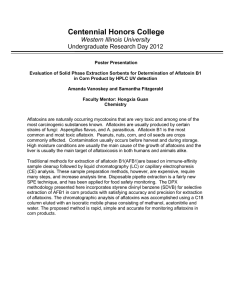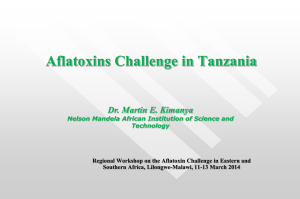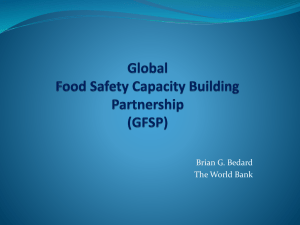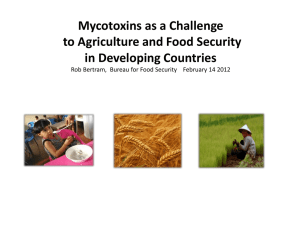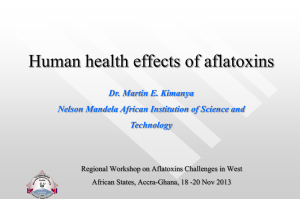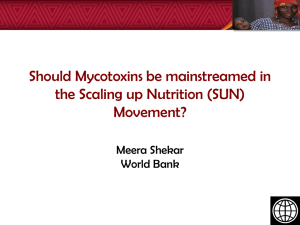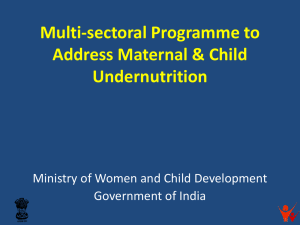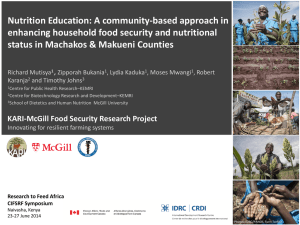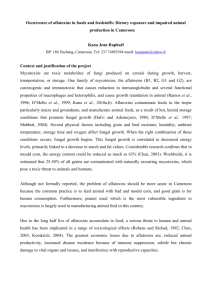Tanzania Food and Nutrition Centre
advertisement
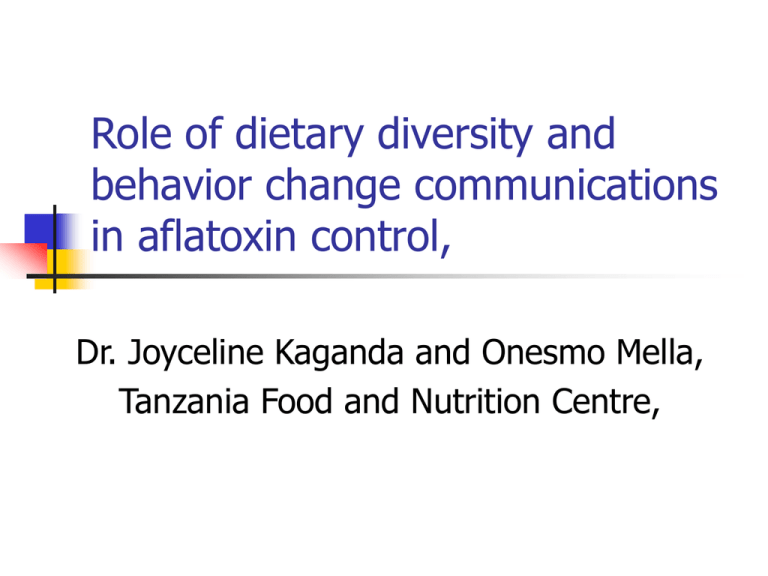
Role of dietary diversity and behavior change communications in aflatoxin control, Dr. Joyceline Kaganda and Onesmo Mella, Tanzania Food and Nutrition Centre, Tanzania Food and Nutrition Centre TFNC is mandated to work on reducing exposure to aflatoxins through promotion of food safety, utilization of products and nutrition education and training. To provide guidance on promotion, protection and support to exclusive breastfeeding for the first six months followed by timely, nutritionally adequate and safe complemented breastfeeding for two years or more. However, little research has been done to generate information and create awareness about aflatoxins TFNC focus on eight priority Areas Infant and young child feeding Vitamin and mineral deficiencies Maternal and child malnutrition Nutrition and HIV and AIDS Children, women and households in difficult circumstances Diet-related non-communicable diseases Household food security Nutrition surveillance, surveys and information management TFNC is mandated as the Tanzanian government’s agency leading the technical coordination and implementation of the National Nutrition Strategy (NNS), of w “nutrition advocacy and communication” is one of eight priority strategies. Infant and Young Child Feeding Breastfeeding Status Under 6 Months Why talk of aflatoxin? Aflotoxin is produced by fungal action during production, harvest, storage, and food processing Aflatoxins are produced as secondary metabolites when the temperatures are between 24 and 35°C, The fungi responsible are everywhere and can affect many dietary staples including; rice, corn, cassava, nuts which are basis of complementary foods Food insufficiency and lack of diversity substantially contribute to the susceptibility of individuals and communities to aflatoxins Key interventions that fall under dietary improvement include Growing crop varieties that are genetically more resistant to the growth of the fungus and the production of aflatoxins can be another useful control strategy Proper drying of crops before storage so as to reduce the amount of moisture can prevent the development of aflatoxins. Advise women of reproductive age and other caregivers on how to improve dietary intake for themselves and their young children, Promote food preparation and processing technologies that increase bioavailability and absorption of vitamins and minerals. Food preparation and processing technologies to reduce aflatoxins Rapid and proper drying, sorting cleaning, smoking, post harvest insect control, disposing of visibly moldy or damaged kernels before storage physically (sorting, physical segregation, flotation etc.), Simple food preparation methods such as sorting, washing, crushing, and dehulling may reduce aflatoxin levels These technologies should be improved to reduce women workload What has been done in BCC TFNC has developed key information, education and communication (IEC) materials on a wide variety of nutrition and health topics for both the general population and as job aides for service providers. has also developed nutrition education radio programs eg “Chakula na Lishe” on Radio Tanzania, aired weekly. TFNC also produced in-house a limited number of nutrition information films for television and private viewing. Use of mobile telephone to send messages on nutrition and health information Nevertheless, TFNC has been using malting and fermentation technologies as means of reducing Mycotoxin in cereal based complementary foods eg LISHE SBCC and Aflatoxins Global Political Economy, Climate Change ADVOCACY Wider Society SOCIAL MOBILIZATION IEC BCC Community (church, mosques, schools, LGAs, CBOs, etc.) Social Support Networks SOCIAL (Family, Friends, Peers, Neighbors, Colleagues) MARKETING Individual NUTRITION EDUCATION SBCC strategy TFNC is in the process of formulating SSBCC technical working group (TOR) SBCC programming involves five main phases Understanding the social and behavioral dimensions of the situation Focusing and designing a communication strategy to remove barriers and to motivate pro-nutrition behaviors Creating interventions and materials for change Implementing and monitoring the change process Conclusion 43% of burden of disease is/may be modulated by aflatoxin (WHO) Contamination is not easily prevented without significant investment in production, drying, storage and preparation facilities. These investments currently add significantly to the cost of delivering “safe” food to the people of the Tanzania and especially infants and young children To achieve these ……………….. SBCC and Aflatoxins Global Political Economy, Climate Change ADVOCACY Wider Society SOCIAL MOBILIZATION IEC BCC Community (church, mosques, schools, LGAs, CBOs, etc.) Social Support Networks SOCIAL (Family, Friends, Peers, Neighbors, Colleagues) MARKETING Individual NUTRITION EDUCATION

